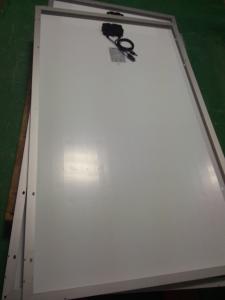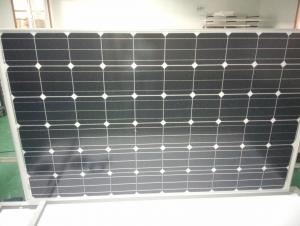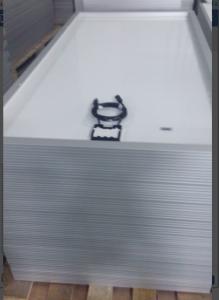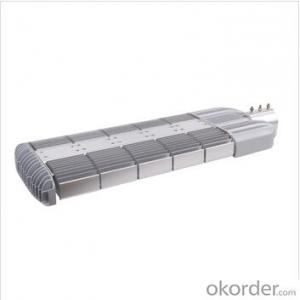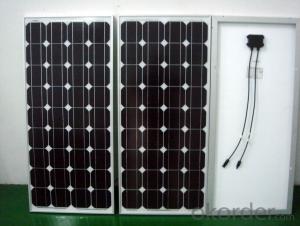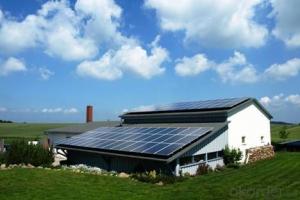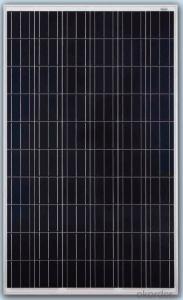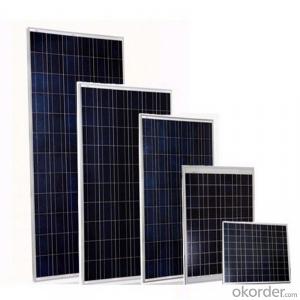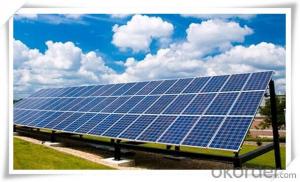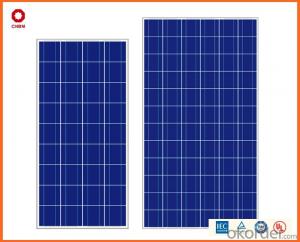240W Poly Solar Panel with TUV and UL Certification for Trailer Homes
- Loading Port:
- Shanghai
- Payment Terms:
- TT or LC
- Min Order Qty:
- -
- Supply Capability:
- 3000pcs watt/month
OKorder Service Pledge
OKorder Financial Service
You Might Also Like
Mechanical Characteristics
Model GS-P660240
Max-power Pm(W) 240
Max-power voltage Vmp(V) 30.7
Max-power current Imp(A) 8.15
Open-circuit voltage Voc(V) 37.3
Short-circuit current Isc(A) 8.85
Dimension(mm) 1650*992*45mm
Weight(kg) 19
Operating Conditions
Operating Temperature -40~85°c
Storage Temperature -40~85°c
Maximum system voltage DC 1000V
Temperature and Coefficients
NOCT 48± 2°c
Temperature coefficient of Voc(%/K) -0.34
Temperature coefficient of Isc(%/K) 0.09
Power temperature coefficient(%/K) -0.37
Quality and Safety
1. Rigorous quality control meets the highest international standards.
2. High-transmissivity low-iron tempered glass, strong aluminium frame.
3. Using UV-resistant silicon.
4. IS09001/14001/CE/TUV/UL
Warranty
--Peak power of single module is guaranteed in±3% power tolerance
--3 years limited warranty on material and workmanship
--Limited power warranty:10 years 90% and 25 years 80% limited warranty for minimum power output
Package
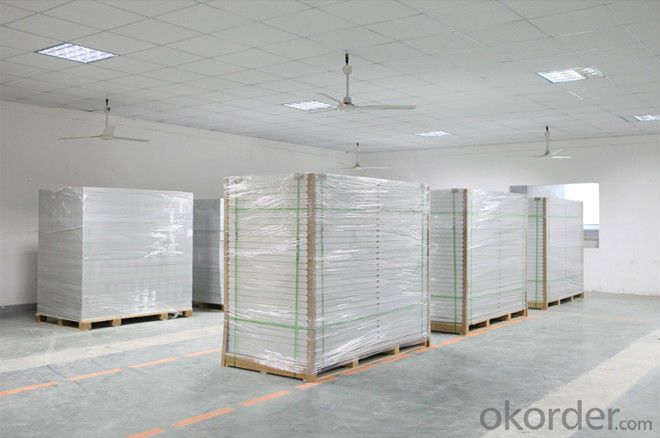

FAQ
I. Will you focus on the safety of the goods during transportation?
Yes, Safety of the cargo is the primary element that we would consider on transportation.
II..How would guarantee the quality will meet the requirements of your clients?
Before shipment, we will have inspection for each batch of goods.
III..What certificates do you have?
IEC,UL,TUV,CSA,etc.
IV..Can you do OEM according to clients’ requirements?
Yes, we have our own brand while we can provide OEM service.
- Q: What maintenance is required for solar panels?
- Solar panels require minimal maintenance. Regular cleaning of the panels to remove dirt, dust, and debris is recommended to ensure optimal efficiency. Additionally, inspecting the panels for any damage or signs of wear and tear is important. It is also advisable to monitor the performance of the solar system regularly. Overall, solar panels are known for their durability and reliability, requiring little ongoing maintenance.
- Q: Are there any restrictions or regulations regarding solar panel installations?
- Yes, there are restrictions and regulations regarding solar panel installations. These can vary depending on the country, state, or local municipality. Some common restrictions include zoning laws, building codes, and utility regulations. These regulations may dictate the size, placement, and connections of solar panels, as well as any necessary permits or approvals required for installation. It is important to consult with local authorities or a professional installer to ensure compliance with all applicable restrictions and regulations.
- Q: My house is aligned exactly North-South, so I have no roof facing South. Is it worth installing solar panels? Are there any good options for dealing with this situation?
- The answer is NO. We can install PV solar panels to properties that are South East – South West facing. Of course it helps if you are 00% South facing but it’s not the end of the world. In fact I would say that the majority of solar panel installations across Britain are not 00% South facing.
- Q: How many solar panels would it take to run an electric motor the needs 480 volts and pulls about 45 to 50 amps?
- Quite a bit to run 480 volts @ 50 amps. Ohms law will give you the basic level your looking for but also you need to consider power storage ... Conversions .... Start up power vs running power levels ... it can be done but this is a bigger system then what I need so I cant just give you an number your panels will be rated in wattage and amperage you then take that power and put it in storage (battery) to inverter system (mine is 20 volt) you will need to have a 480 inverter for your power level. good luck hope I was of some help.
- Q: I think that solar panels are the future and i think that the conventional way of generating electricity is going to be replaced by solar panels. I would like to be part of this industry as an entrepreneur but i do not know how to since i do not have a technical background. I would like to sell solar panels to consumers and to business. Should I start a manufacturing company that manufactures solar panels? Should I buy solar panels from manufactures and sell them to consumers? What should I do?
- actually, i think of it rather is an extremely lifelike purpose for recuperating air high quality and suplying skill. you will not go with to apply it as a highway floor, as deposits from tire treads might degrade its productiveness, yet one among those equipment could actually be built alongside roadways and rail structures. Panels would not could be as extensive as a roadway, as you have practically countless linear area. besides the undeniable fact that, i don't think of it will make a distinction in worldwide climate replace. the time-honored utilising tension for worldwide warming isn't guy-made polution, yet organic phenomena which contain volcanic eruptions. human beings in all probability have some effect, yet its slightly like the entire tea-cup-in-the-swimming-pool difficulty. there is not something that could be executed approximately worldwide warming. keep in mind that the earth's climate is in a relentless cycle from chilly to warm, and back to chilly. i'm confident you have heard of ice a protracted time.
- Q: How much energy can be generated from a solar panel on a clear, bright summer's day for example?
- Well, the maximum amount of energy you can receive with 00 percent efficiency is kilowatt per square meter. This is the energy that hits the Earth's surface. The best commercially available panels are 20-30 percent efficient. Cutting edge technology has gotten this percentage up to 50 percent, but you can't buy these for your home. If you're curious about efficiency, check out a panel's dimensions, find the area in square meters, and use that along with its Watts (divide by 000 to get kilowatts) to get your answer.
- Q: Currently being sold today! I know SunPower corp. commercial panels are about 20%.
- New rollable panels are becoming available that don't have to be permanently attached to a surface and that are more resistant to damage than conventional panels. Right now they are also even less efficient than photo cells at about 0%, but the cost factor may make up the difference. Solar thermal is more efficient than photovoltaic cells. They focus sunlight with mirrors onto a pipe containing a liquid which is then heated to it's boiling point. That turns a turbine to produce power or is harnessed in some other way. The panels are cheap compared to photo cells, don't require perfect manufacture or exotic materials, no expensive maintenance and they are much easier to repair. I don't know of any available to individuals yet but there are at least two companies building generating plants in Nevada with this technology. SunPower is about 22% efficient but even at that rate it will take decades to pay for itself and the panels are unlikely to last that long at anything near optimal efficiency. The cost is just too high at present but solar thermal may provide a good alternative until photovoltaic cells mature, if you can cobble together a system. The final link is about a claimed 80% efficient solar cell that even generates some power at night. It's based on nano-technology, like many promising energy developments in batteries, electrolysis and ethanol production. If it works as advertised it should revolutionize solar tech. Eventually.
- Q: Can solar panels be installed on historical landmarks or monuments?
- Yes, solar panels can be installed on historical landmarks or monuments with careful planning and consideration to preserve the architectural integrity and cultural significance of the site.
- Q: Can solar panels be used to power a water pump?
- Yes, solar panels can be used to power a water pump. Solar panels convert sunlight into electricity, which can be used to power various devices and appliances, including water pumps. This allows for a sustainable and environmentally friendly way to pump water without relying on traditional energy sources.
- Q: Well, I am looking for a cheap way on building a solar panel, instead of buying by the manufacturing stores. I would like to stay in the budget up to ,000 dollars. I want to have Solar Energy for my house because the sun is always shining. Is there a way I can make the Light power some of my house? What would I need? How much time would it take?Where can I get the items I need?
- there is a website that sells a book for $40 thattells you how to do it cheaply check it out just google earth4energy
Send your message to us
240W Poly Solar Panel with TUV and UL Certification for Trailer Homes
- Loading Port:
- Shanghai
- Payment Terms:
- TT or LC
- Min Order Qty:
- -
- Supply Capability:
- 3000pcs watt/month
OKorder Service Pledge
OKorder Financial Service
Similar products
Hot products
Hot Searches
